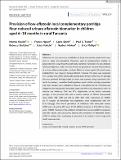| dc.description.abstract | Aflatoxins are toxic secondary metabolites of fungi that colonize staple food crops,
such as maize and groundnut, frequently used in complementary feeding. In
preparation for a large trial, this pilot study examined if provision of a low‐aflatoxin
infant porridge flour made from local maize and groundnuts reduced the prevalence
of a urinary aflatoxin biomarker in infants. Thirty‐six infants aged 6–18 months were
included from four villages in Kongwa District, Tanzania. The study was conducted
over 12 days with a three‐day baseline period and a 10 days where low‐AF porridge
flour was provided. Porridge intake of infants was assessed using quantitative 24‐h
recalls by mothers. Household food ingredients used in infant porridge preparation
and urine samples were collected on Days 1–3 (baseline) and 10–12 (follow‐up).
Aflatoxins were measured in household foods, and AFM1 was measured in urine. At
baseline and follow‐up, 78% and 97%, respectively, of the infants consumed
porridge in the previous 24 h, with a median volume of 220 mL (interquartile
range [IQR]: 201, 318) and 460 mL (IQR: 430, 563), respectively (p < 0.001).
All 47 samples of homemade flour/ingredients were contaminated with AFs
(0.3–723 ng/g). The overall prevalence of individuals with detectable urinary
AFM1 was reduced by 81%, from 15/36 (42%) at baseline to 3/36 (8%) at follow‐
up (p = 0.003). Provision of low‐aflatoxin porridge flour was acceptable to caregivers
and their infants and successfully reduced the prevalence of detectable urinary
AFM1 in infants, thus, confirming its potential to be tested in future large‐scale
health outcomes trial. | en_US |

